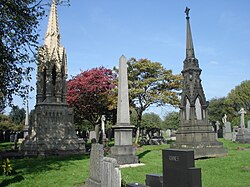| Weaste Cemetery | |
|---|---|
 Weaste Cemetery monuments, 2013 Weaste Cemetery monuments, 2013 | |
| Details | |
| Established | 1 September 1857; 167 years ago (1857-09-01) |
| Location | Cemetery Road, Salford, M5 5NR |
| Country | England |
| Coordinates | 53°28′37″N 2°18′11″W / 53.477°N 2.303°W / 53.477; -2.303 |
| Type | Public |
| Style | Victorian |
| Owned by | Salford City Council |
| Size | 39 acres (16 ha) |
| No. of graves | 332,000+ |
| Website | Official website |
| Find a Grave | Weaste Cemetery |
Weaste Cemetery, previously known as Salford Borough Cemetery, is a public Grade II listed Victorian cemetery in Weaste, Salford. Opened in 1857, it is the oldest of Salford's four cemeteries, covering 39 acres (16 ha) and containing over 332,000 graves. It was established due to the overcrowding of churchyards, officially opening on 1 September 1857, with its first interment being Joseph Brotherton on 14 January 1857. The cemetery, which was bombed during the 1940 Manchester Blitz, now features a heritage trail and guided tours, with several Grade II listed monuments. It also holds graves of 373 Commonwealth service personnel from both World Wars, with special memorials and listings for those buried abroad and in unmarked graves.
Location
The cemetery is located in Weaste, Salford, and lies south of Eccles New Road (A57 road). It is approached via Cemetery Road.
History
Salford was among the first British local authorities to recognise the overcrowding of churchyards and the need for alternative burial grounds. When originally opened, the cemetery included four chapels and a glazed summer house, which have since all been demolished.
The first interment was that of the popular member of parliament, Joseph Brotherton, who had campaigned for the cemetery and died just before its completion. Brotherton died on 7 January 1857 and his funeral took place a week later, on 14 January. The cemetery was formally opened on 1 September 1857.
Then known as Salford Borough Cemetery, the site was extended by 16 acres (6.5 ha) in 1887, by which time there had been 124,500 burials. The original 21 acres (8.5 ha) site was becoming full and a 2.5 acres (1.0 ha) area bought earlier with the intention of being used as an addition had been compulsorily purchased for development of the Manchester Ship Canal. At that time, the cemetery was making a profit of around £2,500 (equivalent to £351,149 in 2023) per annum.
During the 1940 Manchester Blitz, a German bomb fell on the cemetery in an air raid targeting the nearby docks. Several headstones still bear marks and holes from the shrapnel.
In 2004, a heritage trail was opened through the efforts of Salford City Council, the Friends of the Cemeteries and the Greater Manchester Ecology Unit. Occasional guided tours of the cemetery also take place. Several of the monuments in the cemetery are Grade II listed.
Notable interments
Members of the Bible Christian Church
- Joseph Brotherton (1783–1857), first member of parliament for Salford
- Martha Brotherton (1783–1861), wife of above and writer of first vegetarian cookbook
- William Harvey (1787–1870), cotton mill owner, deacon and activist
- Peter Foxcroft (1819–1896), manager, inventor, preacher and activist
- Edwin Collier (1827–1899), accountant, deacon and activist
- James Clark (1830–1905), minister and activist
Others
- Elkanah Armitage (1794–1876), Lord Mayor of Manchester
- Henry Lee (1817–1904), member of Parliament for Southampton
- Charles Hallé (1819–1895), founder of Hallé Orchestra
- Mark Addy (1838–1890), awarded Albert Medal for saving over 50 people from drowning in the Irwell
- William Norman (1832–1896), awarded Victoria Cross for courage in the Crimea War
- Randall Williams (1846–1898), Victorian showman
- Edward Hardy (1884–1960), member of parliament for Salford South
- William Johnson Galloway (1868–1931), member of parliament for Manchester South West
- Four survivors of the Charge of the Light Brigade
- Eddie Colman (1936–1958), Manchester United player killed in Munich air disaster
-
Joseph Brotherton monument
-
Tomb of Elkanah Armitage
-
Sir Charles Hallé monument
-
Mark Addy monument
-
Grave of Eddie Colman
-
Grave of William Norman, VC
-
Grave of Edward Hardy
-
Grave of Galloway family
War graves
The cemetery contains the graves of 373 Commonwealth service personnel who died during the First and Second World Wars, plus numerous memorials to servicemen buried abroad. Some of the 274 First World War dead lie in war grave plots in both the Church of England and Roman Catholic sections, each plot having a screen memorial listing the dead buried within them, while the 99 Second World War dead are scattered amidst the cemetery and there is also a special memorial listing seven personnel buried in graves that could not be marked.
References
- ^ "Weaste Cemetery". Salford City Council. Retrieved 10 July 2024.
- "The History of Weaste Cemetery". Weaste Cemetery Heritage Trail. Retrieved 10 July 2024.
- Keeling, Neal (3 September 2015). "Poignant memorial to thousands who are buried without a headstone at Salford's biggest cemetery". Manchester Evening News. Retrieved 10 July 2024.
- Shapely, Peter (8 October 2009) . "Brotherton, Joseph (1783–1857), Cowherdite Bible Christian minister and politician". Oxford Dictionary of National Biography (online ed.). Oxford University Press. doi:10.1093/ref:odnb/3575. Retrieved 15 January 2020. (Subscription or UK public library membership required.)
- Historic England. "Weaste Cemetery (1001566)". National Heritage List for England. Retrieved 10 July 2024.
- "Extension of the Salford Borough Cemetery". Manchester Courier and Lancashire General Advertiser. 11 August 1887. p. 6. Retrieved 28 June 2014 – via British Newspaper Archive.
- "Weaste Cemetery, Salford". Retrieved 1 October 2013.
- "Cemetery heritage trail opens". BBC News. 17 November 2004. Retrieved 10 July 2024.
- "Book a Tour". Weaste Cemetery Heritage Trail. Retrieved 10 July 2024.
- "Listed Buildings in Salford". British Listed Buildings. Retrieved 10 July 2024.
- "Salford (Weaste) Cemetery". Commonwealth War Graves Commission. Retrieved 10 July 2024.
